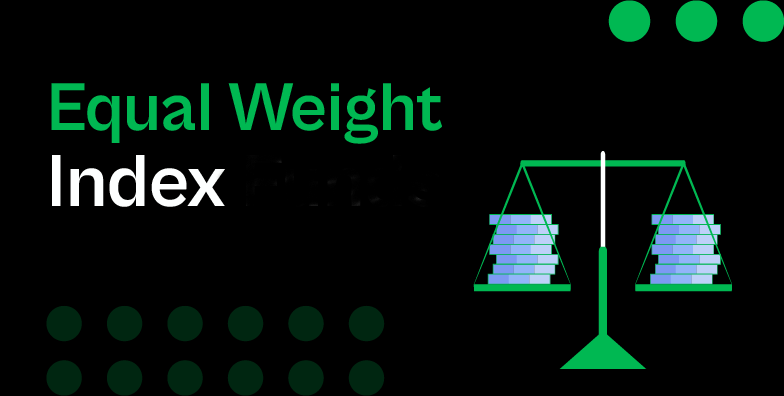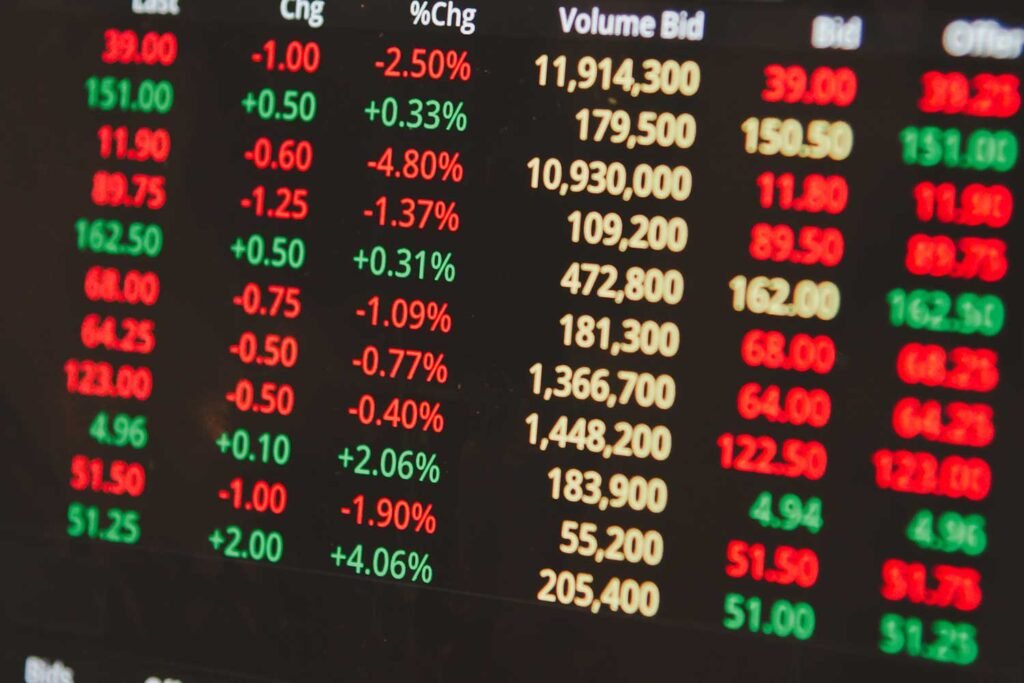Stock indices play an important role in financial markets by reflecting as barometers of market performance and investor sentiment. Calculating and weighting stock indices is crucial for accurately reflecting market movements and helping investors make smart investment choices. Many methods are used to calculate and weight the stock indices, each with its own pros and cons.
This article explores different stock index types, including market-cap weighted, price-weighted, equal-weighted and volatility-weighted indices. It also looks at their calculation methods and importance in the finance world.
What are stock market indices?

A stock market index statistically measures the performance of specific groups of stocks representing a specific market or sector. It acts as a benchmark to assess the overall health and direction of the market for investors.
The main reasons for using stock indices are to:
- Compare current prices levels to past prices to gauge market performance
- Act as a benchmark for portfolio performance
- Enable a basic for index funds, ETFs and other passive investments instrument
Some well-known examples include:
- Dow Jones Industrial Average (DJIA) – monitor 30 large US companies
- S&P 500 – track 500 large US companies
- Nasdaq Composite – track all Nasdaq stock exchange’s listed stocks
- FTSE 100 – track 100 large UK companies on London Stock Exchange
Types of Stock Market Indices
Stock indices use different methods for calculating and weighting different types of indices, each having pros and cons. The main index types are:
Market-Capitalization Weighted Indices

Market-cap weighted stock indices assign weights to individual companies based on their total market cap. It is calculated by multiplying the current stock price by the total number of outstanding shares. Firms with larger market caps have more influence on the index’s performance than those with smaller market caps.
Two famous market-cap weighted indices are:
- S&P 500 – Tracks the performance of 500 large US companies
- Russell 3000 – Covers the performance of 3,000 of the biggest US firms
This weighting scheme reflects the real size and influence of companies in the market. However, critics say overweighting big companies can distort market views and miss outperforming smaller stocks.
Price-Weighted Indices
A price-weighted stock index weights each stock in a company based on its price per share. The index value is calculated by averaging all companies’ share prices. Stocks with higher prices have more impact than lower priced ones, regardless of company size.
Two well-known price-weighted indices are:
- Dow Jones Industrial Average (DJIA) – mointoring 30 large US companies
- Nikkei 225 – included in the 225 stock listed on the Tokyo Stock Exchange
Price-weighted indices offer simple tracking of average stock price performance for a particular market or industry. However, critics argue this method can distort market views by overweighting high share price companies.
Equal-Weighted Indices

Equal-weighted indices give same weight to all constituent companies, regardless of size or share price. The performance of each stock equally impacts the overall index value.
Two popular equal-weighted indices are:
- S&P 500 Equal Weight Index – Track the same 500 firms as S&P 500 but give equal weights to each constituent
- Barron 400 Index – Contain 400 equal-weight US companies
Equal-weighted indices diversify better than market-cap indices by reducing large company influence. However, they need frequent rebalancing to maintain equal weights, increasing turnover and trading costs with respect to market-cap weighted indices.
Volatility-Weighted Indices
Volatility-weighted stock indices give weight to individual stocks based on historical price fluctuations or volatility, typically measured by the standard deviation. Less volatile stocks get higher weights, while more volatile stock get lower weights. This aims to spread risk more evenly across the index constituents and potentially reduce overall portfolio volatility compared to regular market-cap weighted indices.
Examples of volatility-weighted indices are:
- Custom indices created by financial firms using proprietary methodologies to measures volatility and weighting assign
- Nasdaq Victory Volatility Weighted Index Family which iIncludes US large-cap, small-cap and dividend-focused volatility-weighted indices
By incorporating volatility in weights, these indices seek more risk-balanced stock market exposure. However, they may need frequent rebalancing to maintain the desired volatility-based weights.
Calculation Methods
Market-Capitalization Weighted Indices
Formula for calculating a market-cap weighted index is:
$$ Index Value = \frac{\sum (Shares_i \cdot Price_i)} {divisor}
$$
Where:
- $Shares_i$ = Shares outstanding for stock $i$
- $Price_i$ = Price per share of stock $i$
- Divisor adjustments for index composition changes
For example, an index with 3 stocks:
| Stock | Price | Shares | Market Cap |
|---|---|---|---|
| A | $45 | 1M | $45M |
| B | $125 | 300K | $37.5M |
| C | $60 | 500K | $30M |
Total market cap is $112.5 million. Stock A has a weight of 40%, B has 33.3%, and C has 26.7%. The divisor d sets the initial index value, which is adjusted for corporate action, and the composition changes to maintain continuity over time.
Price-Weighted Indices
Formula for price-weighted index is:
$$Index Value = \frac{\sum Price_i}{divisor}$$
Where:
- $Price_i$ = Price per share of stock $i$
- Divisor adjustments for index composition changes
For example, a price-weighted index with 3 stocks priced at $10, $20, and $30 would equal (10 + 20 + 30) / 3 = 20.
The Dow Divisor maintains continuity in the index value which is adjusted for stock splits, spinoffs, and other changes to the index composition. As of June 2018, the Dow Divisor was ~0.14748071991788.
Price-weighted indices like Dow Jones and Nikkei 225 get criticized for letting higher priced stocks disproportionately impact the index, regardless of company size or influence. This can distort the view of overall market performance.
Equal-Weighted Indices
The formula for an equal-weighted index is:
Index Value = (P1 + P2 + … + Pn) / n
Where:
- P1 to Pn are the prices per share of each stock
- n is the total number of stocks
For example, say an index has 3 stocks at $10, $20, and $30 per share. The index value would be (10 + 20 + 30) / 3 = 20.
To keep weights equal, the index gets rebalanced periodically each quarter, typically. This methode involves selling shares that went up in price and buying more shares of stock that went down in price to get back to equal weights.
Equally weighted indices offer a more balanced view of the market by giving small and large companies the same influence. But they also have higher turnover and transaction costs compared to market cap weighted indices.
Volatility-Weighted Indices
The volatility-weighted index formula is:
Index Value = (P1/σ1) + (P2/σ2) + … + (Pn/σn)
Where:
- P1 to Pn are the prices per share of each stock
- σ1 to σn are the volatilities (standard deviation of returns)
As an example, say there are 3 stocks:
| Stock | Price | Volatility (Standard Deviation) |
|---|---|---|
| A | $50 | 20% |
| B | $100 | 25% |
| C | $75 | 15% |
Index Value = (50/0.2) + (100/0.25) + (75/0.15) = 1150
Volatility-weighted indices give lower weights to more volatile stocks and higher weights to less volatile stocks. This aims to equalize risk from each stock and make a more risk-balanced index overall.
These indices need periodic rebalancing to maintain the desired risk profile, as volatility changes over time. While less common than other weighting schemes, volatility weighting focuses specifically on managing risk.
Importance of Stock Indices
Stock indices play an important role in financial markets, performing certain essential functions, which are:
Benchmarking
Stock indices provide a benchmark for investors to compare how their individual portfolios are doing. By tracking market index returns, investors can see if their investments are ahead of or behind the overall market.
Market Sentiment

Stock indices show the overall sentiment and health of the market. Rising index levels signal bullish market sentiment, while falling levels suggest bearish sentiment. Investors and analysts watch indices closely to spot trends and make smart investment decisions.
Investment Products
Stock indices act as a base for several investment products, like index funds and exchange-traded funds (ETFs). These products let investors gain broad market or particular sector exposure without buying individual stocks.
Trading Strategies

Traders analyze index price movements and use technical indicators to make buy or sell decisions. Stock indices are used in several trading strategies, such as algorithmic trading and technical analysis.
Conclusion
To summarize, stock indices are essential tools for tracking market performance, act as benchmarks for investor portfolios, and support important index funds and other investment products. By comprehending index calculation methods like market-cap, price-weighting and more, investors can make better decisions.
With the advancement of financial markets, stock indices will remain crucial for gauging market sentiment and direction, and guiding investors in their investment choices in the complex world of finance.
As stock investing gets more global, investors need to know key market benchmarks across different countries and regions. Our guide on the top 10 global stock indexes gives the rundown on these vital indicators.


